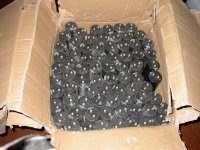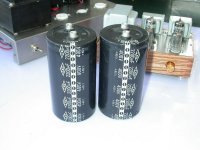A friend works in a equipment company sent me a huge box full of huge capacitors. It weight more than 70kg, 200 pcs 2200uf/400V capacitors in it. It's almost as big as a cola bottle.
I have no reason not to take this huge free gift. I think these caps may be used for tube amplifiers, but for most of the tube amplifiers I have seen a 470uF for power supply is enough. How can I make use of these huge capacitors?
it's not for sale, do not expect to see in the store.
I have no reason not to take this huge free gift. I think these caps may be used for tube amplifiers, but for most of the tube amplifiers I have seen a 470uF for power supply is enough. How can I make use of these huge capacitors?
it's not for sale, do not expect to see in the store.
Attachments
The only reason tube amps have traditional used smaller is
-tube rectifiers arc if exposed to to much capacitance.
-they are expensive
Neither reason should be an impediment to using these caps in a well designed power supply. I frequently use use up to 1000uf in my power supplies. One solution is to restrict yourself to using on Silicone rectifiers, the other is to use 10uf followed by a beefy choke and then your big banks of 2200uf caps. This will prevent valve arcing. Always bypass your big caps with quality film caps - it really counts.
The benefit of going large on your power supply caps is that it will mean an absolutely hum free amp with powerful well controlled bass.
Secondly, consider using these as cathode bypass caps. Most people grossly undersize their cathode bypass caps with various nasty effects of bass and phase shift. If you have big caps then this is the obvious place to use them (bypassed of course).
Finally - if you do not feel you can use them - send them to me and I will find them a very good home.
Shoog
-tube rectifiers arc if exposed to to much capacitance.
-they are expensive
Neither reason should be an impediment to using these caps in a well designed power supply. I frequently use use up to 1000uf in my power supplies. One solution is to restrict yourself to using on Silicone rectifiers, the other is to use 10uf followed by a beefy choke and then your big banks of 2200uf caps. This will prevent valve arcing. Always bypass your big caps with quality film caps - it really counts.
The benefit of going large on your power supply caps is that it will mean an absolutely hum free amp with powerful well controlled bass.
Secondly, consider using these as cathode bypass caps. Most people grossly undersize their cathode bypass caps with various nasty effects of bass and phase shift. If you have big caps then this is the obvious place to use them (bypassed of course).
Finally - if you do not feel you can use them - send them to me and I will find them a very good home.
Shoog
Last edited:
Yes but hopefully he doesn't need 400V caps in the cathode
There free, but yes total overkill in this situation. Might be an excuse for building that lovely direct coupled amp you have always dreamed of.
Shoog
I guess the diode will burn when power on with this cap?
Does a cathod bypass cap need to be 400V? In my FU50 SE it's only 220uf/50V and works fine. Is there any tubes can work under 200V cathod voltage?
Finally, I don't mind to send you one if you wish to pay the shipping cost, or buy anything from our store. I'm serious.
Does a cathod bypass cap need to be 400V? In my FU50 SE it's only 220uf/50V and works fine. Is there any tubes can work under 200V cathod voltage?
Finally, I don't mind to send you one if you wish to pay the shipping cost, or buy anything from our store. I'm serious.
How can I make use of these huge capacitors
OTL
Hi,
what diameters they have, while I need 50mm diameters (while my Cary SLM-100 uses orginal 1250u 450V nippon's, allways 2 stacked connected)
HpW
what diameters they have, while I need 50mm diameters (while my Cary SLM-100 uses orginal 1250u 450V nippon's, allways 2 stacked connected)
I can sell it for $5, but plus $15 for shipping, who will buy?
I'll reserve them for my own porjects.
HpW
Last edited:
It's 66mm diameter x 123mm tall
Hi,
what diameters they have, while I need 50mm diameters (while my Cary SLM-100 uses orginal 1250u 450V nippon's, allways 2 stacked connected)
HpW
With a bank of these, you can make a variable speed motor drive. Or, you can make a diy ultrasonic stone pulverizing machine. Just don't connect them direct to a rectifier tube, they will arc over if the capacitance is more than the datasheet listed maximum capacitance. At these capacitances, even silicon diodes and power transformers need engineering to limit the turn on current. Things like NTC resistors, just plain resistors, etc in the capacitor feed circuit. I'm installing 0.1 ohm 25 W resistors today between my 1500 W transformer and my quad of 10000 uf caps in my power amp to try to keep the room lights from going dim when I turn it on. The incandescence test happens this evening. I put a 3 W 47 ohm resistor between my dynakit ST70 5AR4 rectifier tube and the first 40 uf cap, and it turned transparent showing the red glowing wire inside when I turned the power on- but did not burn out. There is a 5 W 47 ohm resistor there now.
Pity they are not film caps, but are electrolytic. I've been looking for dual 4700 uf of >50V film caps to make the ultimate speaker protector against shorted O.T.'s on dual supply transistor amps , but the bill would be $600. Each. Back to disconnect relays and short detectors like everybody else does.
Pity they are not film caps, but are electrolytic. I've been looking for dual 4700 uf of >50V film caps to make the ultimate speaker protector against shorted O.T.'s on dual supply transistor amps , but the bill would be $600. Each. Back to disconnect relays and short detectors like everybody else does.
Last edited:
They are probably for power factor correction.
A switcher (up to 390V) deliberately imposes a ripple
current that makes the input look perfectly resistive.
But that cap has to hold back all the ripple by itself,
with no quick help from the main switching regulator.
If it regulated upon a shorter time constant, it would
defeat the whole purpose...
This is usually followed by a step down regulator that
reduces the need for such a large cap, and holds the
final output at constant voltage. In this case, the 390V
cap need only hold enough energy for a few cycles, and
not so huge as to filter the PFC ripple current perfectly
smooth by itself.
A switcher (up to 390V) deliberately imposes a ripple
current that makes the input look perfectly resistive.
But that cap has to hold back all the ripple by itself,
with no quick help from the main switching regulator.
If it regulated upon a shorter time constant, it would
defeat the whole purpose...
This is usually followed by a step down regulator that
reduces the need for such a large cap, and holds the
final output at constant voltage. In this case, the 390V
cap need only hold enough energy for a few cycles, and
not so huge as to filter the PFC ripple current perfectly
smooth by itself.
Does a cathod bypass cap need to be 400V? In my FU50 SE it's only 220uf/50V and works fine. Is there any tubes can work under 200V cathod voltage?
Comments like this amaze me from someone who sells high voltage kits to the public.
There is an old saying here in Canada "It's better to have someone think your stupid, then to open your mouth and prove your stupid"
(Go easy on me mods)
Your business would do better if you stayed out of such forums.
Personally, I'm glad you participate in these forums.
You should know your kits inside and out, even if you lack the knowledge to design them.
Frankly I think you sell enough used capacitors in your kits already.
It must be nice to sell things from way over there without the fear of repercussions.
We all know your skirting forum rules by saying "these are not for sale.....$5 plus $15 shipping", but hey, at least you did not use a Sock Puppet this time.
For future reference a dealer should correctly spell "Cathode", you should work on your Engrish, lot's of non-engrish speaking members spell perfectly.
- Status
- This old topic is closed. If you want to reopen this topic, contact a moderator using the "Report Post" button.
- Home
- Amplifiers
- Tubes / Valves
- What amp can make use of these large caps?

